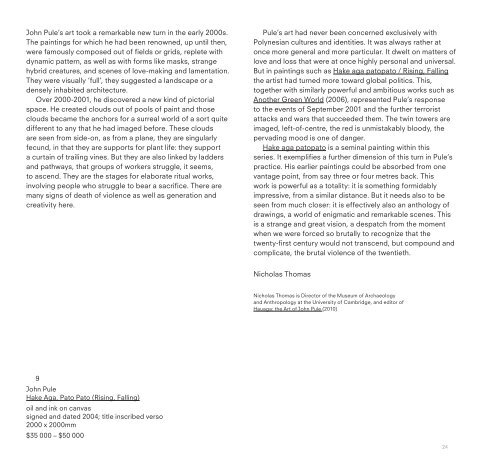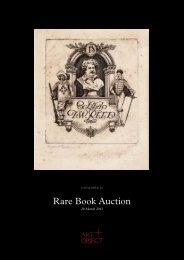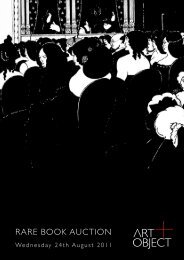Download PDF catalogue - Art+Object
Download PDF catalogue - Art+Object
Download PDF catalogue - Art+Object
Create successful ePaper yourself
Turn your PDF publications into a flip-book with our unique Google optimized e-Paper software.
John Pule’s art took a remarkable new turn in the early 2000s.<br />
The paintings for which he had been renowned, up until then,<br />
were famously composed out of fields or grids, replete with<br />
dynamic pattern, as well as with forms like masks, strange<br />
hybrid creatures, and scenes of love-making and lamentation.<br />
They were visually ‘full’, they suggested a landscape or a<br />
densely inhabited architecture.<br />
Over 2000-2001, he discovered a new kind of pictorial<br />
space. He created clouds out of pools of paint and those<br />
clouds became the anchors for a surreal world of a sort quite<br />
different to any that he had imaged before. These clouds<br />
are seen from side-on, as from a plane, they are singularly<br />
fecund, in that they are supports for plant life: they support<br />
a curtain of trailing vines. But they are also linked by ladders<br />
and pathways, that groups of workers struggle, it seems,<br />
to ascend. They are the stages for elaborate ritual works,<br />
involving people who struggle to bear a sacrifice. There are<br />
many signs of death of violence as well as generation and<br />
creativity here.<br />
9<br />
John Pule<br />
Hake Aga, Pato Pato (Rising, Falling)<br />
oil and ink on canvas<br />
signed and dated 2004; title inscribed verso<br />
2000 x 2000mm<br />
$35 000 – $50 000<br />
Pule’s art had never been concerned exclusively with<br />
Polynesian cultures and identities. It was always rather at<br />
once more general and more particular. It dwelt on matters of<br />
love and loss that were at once highly personal and universal.<br />
But in paintings such as Hake aga patopato / Rising, Falling<br />
the artist had turned more toward global politics. This,<br />
together with similarly powerful and ambitious works such as<br />
Another Green World (2006), represented Pule’s response<br />
to the events of September 2001 and the further terrorist<br />
attacks and wars that succeeded them. The twin towers are<br />
imaged, left-of-centre, the red is unmistakably bloody, the<br />
pervading mood is one of danger.<br />
Hake aga patopato is a seminal painting within this<br />
series. It exemplifies a further dimension of this turn in Pule’s<br />
practice. His earlier paintings could be absorbed from one<br />
vantage point, from say three or four metres back. This<br />
work is powerful as a totality: it is something formidably<br />
impressive, from a similar distance. But it needs also to be<br />
seen from much closer: it is effectively also an anthology of<br />
drawings, a world of enigmatic and remarkable scenes. This<br />
is a strange and great vision, a despatch from the moment<br />
when we were forced so brutally to recognize that the<br />
twenty-first century would not transcend, but compound and<br />
complicate, the brutal violence of the twentieth.<br />
Nicholas Thomas<br />
Nicholas Thomas is Director of the Museum of Archaeology<br />
and Anthropology at the University of Cambridge, and editor of<br />
Hauaga: the Art of John Pule (2010)<br />
24

















